|
The Woodland Education Centre |
|
|
The Woodland Education Centre |
|
Ecological Survey 1999
Autumn Cut Sections (1, 3 and 8)
Summary
| (Please note, the colour coding given to each section description matches that of the Belt Transect Diagram to aid understanding.) |
Section 1
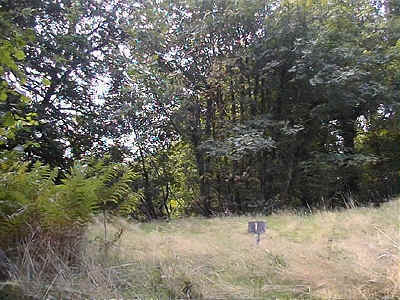 |
Section 1 is the smallest of the Heathland Restoration Project sections.
It is a triangular area dominated by adjacent woodland. It therefore has a much cooler,
shadier microclimate than the other sections. The ground layer in this area was characterised by the build up of considerable quantities of leaf litter from the surrounding trees. |
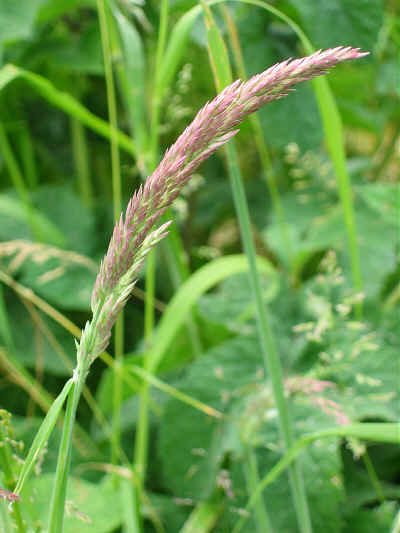 |
The plant cover in section 1 was dominated by grasses, particularly Yorkshire
Fog (left)
and Common Bent. Some Sweet Vernal Grass also occurred in this section, as well as in sections 3 and 8. This is one of the earliest grasses to flower, flowering as early as April. By the time the annual survey was carried out in July, much of this grass had died back and it was not picked up in the quadrats. A variety of mosses were also interwoven amongst the base of the grasses, particularly Eurhynchium praelongum. |
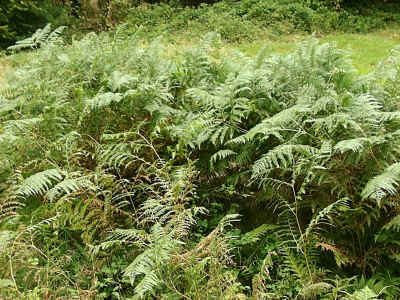 |
The lower part of the section contained a stand of Bracken. |
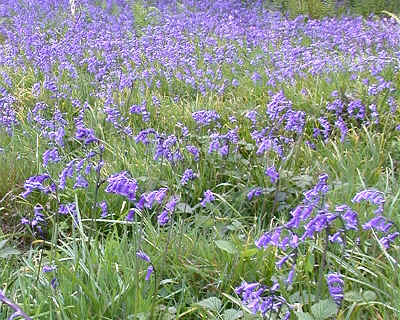 |
Bluebells were a very dominant species on this section in the spring.
However, by the time the survey was carried out in July, the Bluebells had largely died
back, so their real dominance in the section is not truly reflected in the quadrat data. Bluebells are a remnant woodland species. The woodland on the northern border of the project site is famous locally for its massed stands of Bluebells. Narrow Buckler Fern, another characteristic woodland species, occurred in over a quarter of the quadrats sampled. |
Section 3
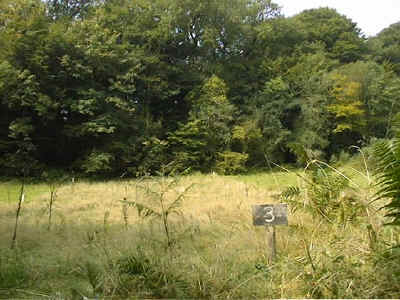 |
Section 3 was similarly dominated by the grasses Yorkshire Fog and Common
Bent. Some Wood Sedge was also present in this section, although much less than was present in the neighbouring spring cut section 4. There was some bracken in the lower part of the section (left foreground). |
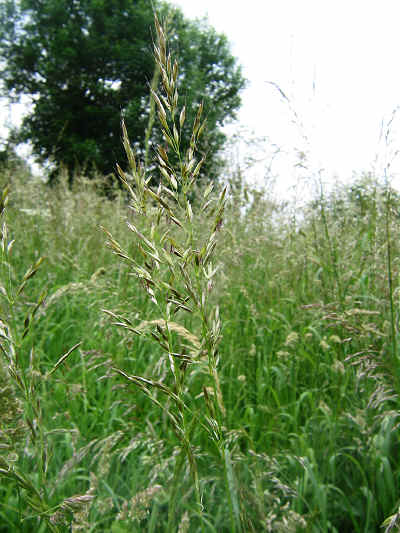 |
A significant amount of False Oat Grass (left) occurred in the lower half of the section, although this again was not
reflected in the quadrats. This grass has tall, slightly drooping flower heads. It is a much taller grass than the others on the section and therefore stands out.
|
 |
Bluebells were also one of the dominant species in section 3. |
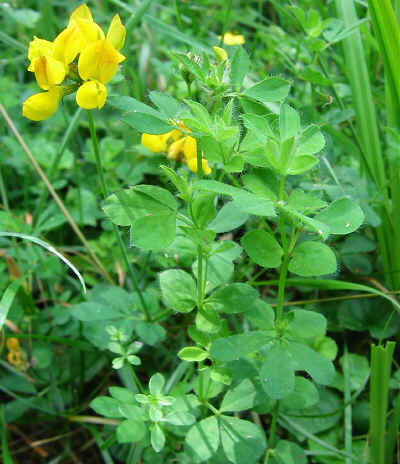 |
Section 3 is a much larger section than section 1 and more resembles a
meadow habitat with a variety of herbs mixed in amongst the grass sward. Greater Bird's-foot Trefoil (left), Yellow Pimpernel and violets occurred in significant amounts in the lower half of this section. These species were either absent or rare in section 1. |
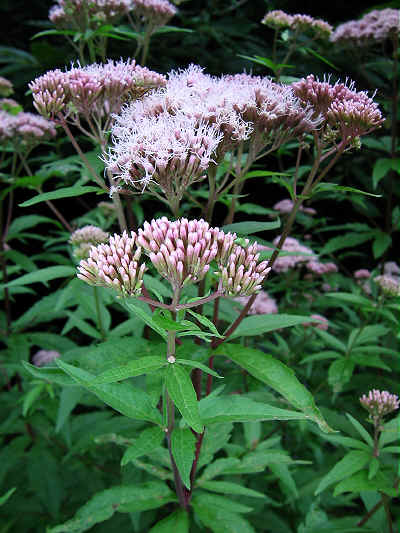 |
Section 3 also contained a variety of taller herbs such as Hemp-agrimony (left), Hedge Woundwort, Wood Sage, Common Figwort and Marsh Thistles.
|
Section 8
(Autumn cut plus initial general 'weed' control)
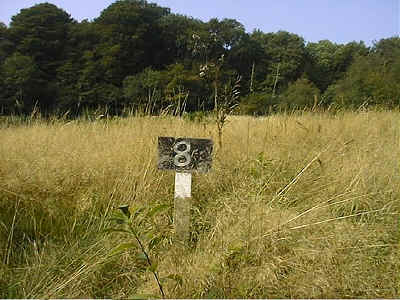 |
Section 8 appeared to be a predominantly grassland habitat on first
observation. However, this was somewhat deceptive and on closer examination, this section
was very noticeably stratified into vertical layers. There was a well established ground layer of mosses, with a taller shrubby layer of Heather over this, all overtopped by tall, waving flowering grasses. When examined superficially, the grasses were therefore the major vegetation visible. |
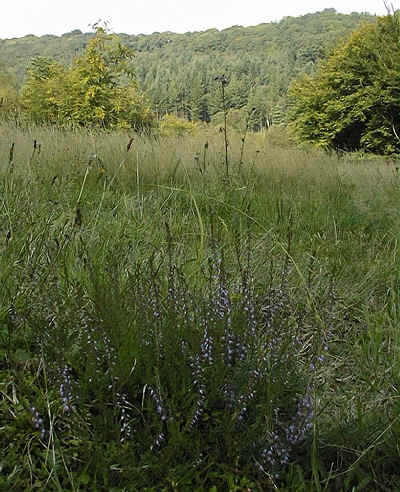 |
This section contained substantial amounts of Heather, but much less Bell Heather than in adjacent spring cut section 7. Along with sections 7 and 9, this section most resembled a heathland habitat.
|
 |
A few plants of Bristle Bent
(left), which is a heathland grass, had colonized this section. This grass gets its name from the very narrow bristle-like leaves. It grows in distinct clumps rather than creeping and covering large areas. |
Dominant Plants in
Autumn Cut Sections in 1999
with figures from 1998 for comparison.
Characteristic heath species
are in bold print
A + sign indicates the species was present, but not recorded in the quadrats.
| Species | Section 1 | Section 3 | Section 8 | |||
| Overall % frequency (mean % cover in brackets) | 1999 | 1998 | 1999 | 1998 | 1999 | 1998 |
| Yorkshire Fog | 100 (31) | 90 (44) | 100 (32) | 100 (60) | 67 (17) | 82 (25) |
| Common Bent | 95 (56) | 95 (51) | 94 (43) | 90 (23) | 83 (9) | 82 (21) |
| Eurhynchium praelongum | 81 (43) | 10 (2) | 65 (19) | 10 (3) | 72 (33) | 12 (1) |
| Bramble | 76 (14) | 57 (9) | 65 (20) | 75 (13) | 33 (4) | 41 (6) |
| Bluebell | 71 (17) | 67 (4) | 60 (8) | 85 (8) | + | + |
| Thuidium tamarascinum | 67 (17) | 14 (6) | 30 (10) | 5 (0.5) | 78 (24) | 35 (11) |
| Polytrichum formosum | 29 (6) | 14 (1) | 5 (0.1) | 10 (6) | 67 (45) | 53 (14) |
| Narrow Buckler Fern | 29 (4) | 0 | 5 (3) | 0 | 0 | 0 |
| Silver Birch | 19 (2) | 24 (2) | 10 (2) | 15 (4) | 33 (8) | 41 (5) |
| Heath Woodrush | 14 (2) | 14 (2) | 10 (2) | 5 (0.5) | 33 (4) | 24 (3) |
| Velvet Bent | 10 (3) | 5 (0.5) | 50 (14) | 10 (1) | 39 (6) | 0 |
| Hypnum jutlandicum | 5 (0.2) | 0 | 0 | 15 (2) | 39 (8) | 24 (8) |
| Common Dog-violet | 5 (0.4) | 0 | 65 (24) | 70 (12) | 28 (3) | 47 (4) |
| Wood Sedge | 5 (1) | 0 | 20 (6) | 20 () | 11 (2) | 0 |
| Smooth-stalked Sedge | 5 (0.4) | 10 (2) | 0 | 0 | 50 (5) | 12 (4) |
| Yellow Pimpernel | 5 (0.5) | 0 | 40 (4) | 25 (3) | 17 (0.5) | 12 (1) |
| Greater Bird's-foot Trefoil | 0 | 0 | 45 (12) | 20 (4) | 0 | 0 |
| European Gorse | 0 | 5 (0.5) | 10 (5) | 20 (3) | 72 (25) | 53 (12) |
| Heather | 0 | 0 | 0 | 0 | 61 (19) | 18 (3) |
| Slender St. John's-wort | 0 | 5 (0.1) | 20 (1) | 25 (2) | 61 (5) | 53 (6) |
| Percentage frequency = the percentage of the total number of quadrats sampled over the whole site which contain the species. For example, a percentage frequency of 100%, means that the species was found in all quadrats sampled. |
| Summary: Comparison between the sections: All three autumn cut sections were dominated by grasses, although section 8 was considerably different to sections 1 and 3, having an abundance of more typical heath species such as Heather, gorse and Slender St John's-wort, as well as the grasses. The management in section 8 has differed from that in sections 1 and 3 in only one respect: - species viewed as being undesirable to heathland regeneration in section 8 were spot treated once with 'Roundup', a biodegradable herbicide, in the early stages of the project. This may be responsible for some of the observed differences between section 8 and the other two autumn cut sections. Section 8 is also in the northern half of the Heathland Restoration Project area. This half of the site is much more open, less dominated by woodland and has a much warmer microclimate than sections 1 - 4 in the southern half of the project site. It is likely that these environmental differences are favouring the development of more typical heath species in the northern half of the project site. Environmental differences between section 8 and sections 1 and 3 are also reflected in the fact that sections 1 and 3 were dominated by Bluebells in the spring, while Bluebells were only present in isolated patches in section 8. All three sections had considerable stands of bracken, although as this tended to be clumped together in the lower halves of the sections, its extent was often not reflected in the quadrat data. The autumn cut sections in more detail:
Changes since the previous year:
|
>> Continue to Spring, Summer and Autumn Cut Section Description
Ecological Survey 1999 |